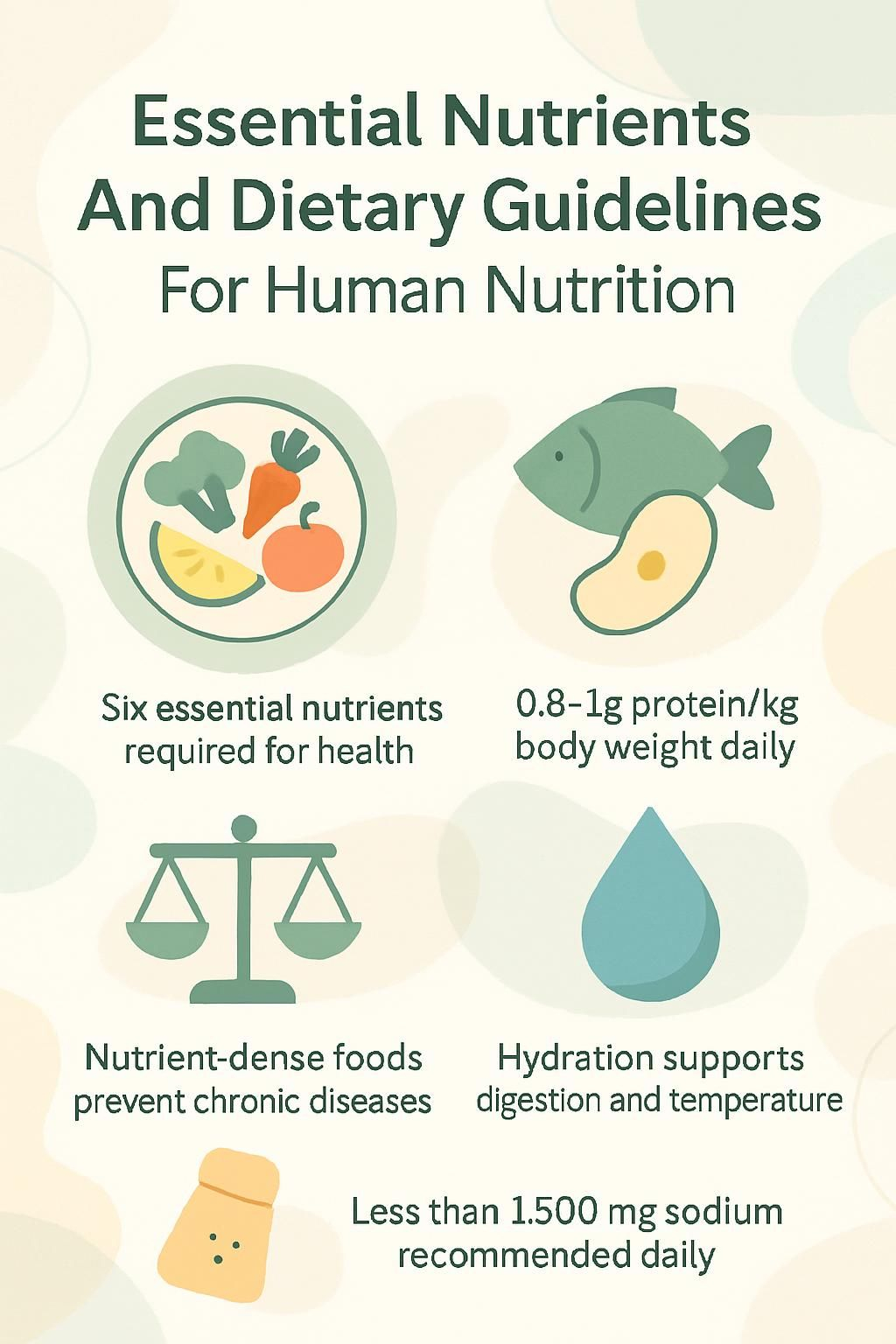Essential Nutrients And Dietary Guidelines For Human Nutrition
Our Nutrition Assistant AI Suite will transform your body. You will lose fat, get toned, and build muscle. Gain confidence and optimal health.
Many people feel unsure about what a healthy diet looks like and how to meet the body’s needs. Advice often conflicts, which adds to the confusion. As I studied human nutrition, I learned how food turns into energy and raw materials for every tissue in the body.
In this guide, I break down essential nutrients, the Dietary Guidelines for Americans, major food groups, and simple ways to build balanced meals. You will find clear answers and practical steps you can use today.
Key Takeaways
- Humans need six essential nutrients, carbohydrates, proteins, fats, vitamins, minerals, and water, to support growth, energy, and normal body function (Dietary Guidelines for Americans 2020-2025).
- Daily targets often used in nutrition planning include protein at 0.8 to 1 gram per kilogram of body weight, fiber at 38 grams for men and 25 grams for women, calcium at 1,000 milligrams, vitamin C at 90 milligrams for men and 75 milligrams for women, and sodium under 1,500 milligrams.
- Nutrient-dense foods, such as fruits, vegetables, whole grains, lean proteins, and dairy sources rich in calcium and vitamin D, can lower the risk for diabetes and heart disease.
- Hydration matters because water supports digestion, nutrient transport, and body temperature. Total fluid intake includes both beverages and foods that contain water, such as low-fat milk or potatoes.
- Needs change with age. Infants rely on breast milk or formula. Children need extra protein and calcium for growth. Older adults often require more calcium and vitamin D for bone health.

What does nutrition mean and why is it important?

Nutrition studies how substances in food affect health and how the body uses them. I focus on nutrition because the right balance of nutrients helps prevent poor nutrition, malnutrition, and disease.
What is the definition of nutrition?
Nutrition is the process of taking in and using nutrients for growth, energy, and health. Nutrients are chemical substances in food, including protein, carbohydrate, fat, vitamins, minerals, and water.
These substances are found in grains, fruits and vegetables, dairy, meat, eggs, legumes, nuts, and vegetable oil. The human digestive system breaks food into small units so each cell can get what it needs.
Nutritional science explores how the body absorbs and uses each essential nutrient through digestion and metabolism. It draws on physiology, biochemistry, and cell biology to connect diet to health outcomes.
A balanced diet supplies all six major classes of nutrients each day. If I fall short, poor nutrition can lead to malnutrition or raise the risk of illness.
Food is not just fuel; it’s information. It talks to your DNA and tells it what to do. – Dr. Mark Hyman
Why is nutrition important for human health?
Good nutrition can lower the risk for diabetes, heart disease, and stroke. Research, including studies in the American Journal of Clinical Nutrition, shows balanced meals help manage body weight, blood pressure, and cholesterol.
Healthy choices power daily activity, support the brain and immune system, and aid healing. Vitamins and minerals help cells repair normal wear and tear from stress or illness.
Recovery after surgery or sickness often raises needs. Protein supplies essential amino acids to rebuild tissue. Fats provide extra calories and help the body absorb fat-soluble vitamins.
Evidence links diets rich in fruits and vegetables to better mood over time, likely due to micronutrients such as vitamin B6 and magnesium. Following a recommended dietary allowance helps children grow and also supports hydration, which every cell needs. This article is for education. For personal care, I talk with a clinician or a registered dietitian.
The six essential nutrients explained
I study how the body relies on six essential nutrients to stay healthy. Each one plays a different role in growth, energy, and maintenance.
How do carbohydrates provide energy for the body?
Carbohydrates are my main energy source. They provide 4 kilocalories, or 17 kilojoules, per gram. Common sources include white bread, cereals, fruit, vegetables, table sugar, and grains. Carbs appear as starch, sugar, and dietary fiber.
Guidelines suggest 45 to 65 percent of total energy should come from carbohydrates. One slice of white bread, about 25 grams, contains around 12 grams of carbohydrate and roughly 67 kilocalories.
During digestion, enzymes break starches and sugars into glucose. Cells use glucose right away for energy or store it as glycogen in the liver and skeletal muscle.
Complex carbs in whole grains also add fiber. A common goal is more than 38 grams of fiber per day for men and at least 25 grams for women.
Glucose is vital fuel for the brain and the nervous system.
Next, I look at how proteins help the body build and repair tissues.
What role do proteins play in building and repairing tissues?
Proteins are the body’s building blocks. Each gram of protein gives 4 kilocalories. Protein supports muscle repair, enzymes, and hormones. After tough workouts or an injury, protein helps rebuild damaged tissue.
Most adults aim for 0.8 to 1 gram of protein per kilogram of body weight per day. Children often need a higher percentage as they grow, about 5 to 20 percent of daily energy for ages one to three, 10 to 30 percent for older children and teens. Adults can target 10 to 35 percent.
For example, 100 grams of lean ground beef provides about 25 grams of protein plus iron and zinc. Across the globe, protein sources provide roughly 8 to 16 percent of dietary energy, according to estimates from public health organizations.
How do fats support bodily functions and store energy?
While protein builds tissue, fats support many functions and serve as a dense energy reserve. Fats provide 9 kilocalories per gram, which is more than carbohydrates or protein. The body stores fat for times when energy intake is low.
Fats help absorb fat-soluble vitamins, vitamins A, D, E, and K. Essential fatty acids from nuts and seeds protect cell membranes and support the brain. Butter shows how dense fat can be. A 5 gram pat contains about 4 grams of fat and around 36 calories.
General ranges for fat vary by age. Children 1 to 3 years may need 30 to 40 percent of calories from fat. Ages 4 to 18 often aim for 25 to 35 percent. Adults usually target 20 to 35 percent to support heart health.
Experts also suggest specific ranges for polyunsaturated fats. n-6 fatty acids may provide 5 to 10 percent of total calories. n-3 fatty acids may provide about 0.6 to 1.2 percent. These ranges help with normal tissue function across life stages.
Why are vitamins essential for metabolism?
Vitamins act as helpers for thousands of chemical reactions in metabolism. Water-soluble vitamins, such as the B vitamins and vitamin C, help convert carbohydrates like fructose and maltose into usable energy.
The B vitamin group supports the brain and energy production. Vitamin C aids tissue growth and also supports the immune system.
Fat-soluble vitamins A, D, E, and K drive other key processes. Vitamin D helps with calcium absorption for strong bones. Many people aim for 10 to 15 micrograms daily to support bone health.
Deficiencies can signal a problem. Low vitamin B6 status or low blood levels of 25-hydroxyvitamin D may point to nutritional gaps that can affect metabolism and growth.
What minerals are critical for body processes?
Like vitamins, minerals keep body systems working. Calcium, phosphorus, and magnesium support bones and teeth. Sodium and potassium control nerve signals and help balance fluids inside and outside cells.
I check food labels to watch my sodium intake. Many people consume 3,000 to 4,500 milligrams per day, while many plans encourage limits near 1,500 milligrams for better blood pressure.
Iron helps the body make hemoglobin in red blood cells, which carries oxygen. Men often need about 8 milligrams per day. Women of childbearing age may need up to 18 milligrams. Trace minerals such as copper, zinc, selenium, and iodine support enzymes and hormones.
Calcium needs are around 1,000 milligrams per day for most adults. Potassium targets are higher, near 4,700 milligrams per day. These goals come from Dietary Reference Intake reports and are used worldwide.
Why is water vital for hydration and bodily functions?
Water supports every cell and process in my body. Many foods contribute water. For example, a boiled potato weighing 135 grams contains about 104 grams of water. One cup of low-fat milk, 244 grams, supplies around 218 grams of water.
Water is not a source of energy, but it moves nutrients, aids digestion, and controls temperature. Adequate fluid keeps metabolism steady, helps carry away waste in urine, and protects every cell during daily activity.
What are macronutrients and micronutrients?
Macronutrients and micronutrients work together like a team. Understanding both helps me make better precision nutrition choices.
What are macronutrients and why do we need them in large amounts?
Carbohydrates, proteins, and fats are macronutrients. They provide energy and the materials the body uses to build and repair tissue. Carbohydrates and proteins give 4 kilocalories per gram. Fats give 9 kilocalories per gram.
In many diets, 50 to 60 percent of energy comes from carbohydrates, 12 to 15 percent from protein, and 30 to 40 percent from fat. In lower income settings, carbohydrates often provide an even larger share, while protein and fat may be lower.
The body needs macronutrients in gram amounts each day. Lipids store energy for later use. Proteins build muscles and other tissues, which contain nitrogen. Carbohydrates fuel cells as glucose. Too little intake can cause problems such as poor growth in children or fatigue in adults.
What are micronutrients and why are they essential in smaller amounts?
Micronutrients are vitamins and minerals that the body needs in small amounts, often milligrams or micrograms. Water-soluble vitamins include the B-complex and vitamin C. Fat-soluble vitamins include A, D, E, and K.
Minerals come in two groups. Macrominerals include calcium and magnesium. Microminerals include iron, copper, zinc, selenium, and iodine. Many of the microminerals are needed at less than 100 milligrams per day.
Even in tiny amounts, these nutrients help enzymes work. They support energy release from food, tissue growth, and hormone balance. Deficiencies can lead to anemia or thyroid issues. To prevent this, health agencies publish intake targets such as Reference Daily Intake values.
What are the dietary guidelines for balanced nutrition?
Dietary guidelines give clear targets for healthy eating. I use them to plan meals, keep a steady body mass index, and meet my daily nutrition goals.
What is the recommended daily intake for essential nutrients?
My body needs specific amounts of key nutrients each day for energy, growth, and protection. These ranges come from strong evidence and can guide planning.
| Nutrient | Recommended Daily Intake | Details |
|---|---|---|
| Protein | 0.8–1 g/kg body weight | Supports muscle, tissue repair, enzymes, and hormones. |
| Dietary Fiber | 38 g (men), 25 g (women) | Aids digestion, supports heart health, helps with fullness. |
| Vitamin C | 90 mg (men), 75 mg (women) | Smokers may need +35 mg per day, supports immunity and collagen. |
| Calcium | 1,000 mg | Needed for bones, teeth, muscle function, and nerve signaling. |
| Vitamin D | 10–15 mcg | Helps absorb calcium, supports muscle, bones, and immunity. |
| Iron | 8–18 mg | Supports healthy red blood cells, higher for many women. |
| Potassium (AI) | 4,700 mg | Regulates fluid balance, nerve signals, and muscle contraction. |
| Sodium (AI) | 1,500 mg | Supports fluid balance and nerve function, aim for lower intake. |
How do portion control and food variety contribute to balanced nutrition?
Portion control keeps calories in check and prevents overeating foods high in added sugar or saturated fat. MyPlate suggests filling half the plate with fruits and vegetables, one quarter with grains, and one quarter with protein. Then add a dairy serving.
Balanced portions help me meet targets without going over on calories or sodium. Variety also matters. Rotating foods across all five groups brings in many vitamins and minerals, such as thiamine and iron, that support the body’s processes.
I notice that eating more plant foods raises my fiber intake and provides micronutrients I might miss otherwise. This pattern supports long term heart health and keeps blood pressure in a healthy range.
Why are nutrient-dense foods important?
Nutrient-dense foods pack more vitamins, minerals, and beneficial compounds per calorie. Leafy greens, for example, provide vitamin K, calcium, and fiber at a low calorie cost. Beans supply protein and iron, which can help prevent anemia.
Choosing nutrient-dense options reduces the chance of missing key nutrients that cells need to repair and grow. I read labels and food composition tables to favor foods that deliver more nutrition for the calories. This supports the Dietary Guidelines for Americans and keeps me on track with human nutrition goals.
Major food groups and their nutritional benefits
Each food group brings something unique. Think of them as different tools in the same toolbox.
How do fruits and vegetables provide vitamins, minerals, and fiber?
Fruits and vegetables are primary sources of vitamins, minerals, and fiber. An orange weighing 131 grams has about 15 grams of carbohydrate, 1.3 grams of protein, 0.1 gram of fat, and roughly 114 grams of water.
An apple at 138 grams provides about 21 grams of carbohydrate, very little fat or protein, and around 116 grams of water. Boiled green peas, 80 grams, offer about 11 grams of carbohydrate and about 4 grams of plant protein.
Vitamin C in oranges supports metabolism and tissue repair. Vitamin A in carrots supports vision. Bananas provide potassium, which helps muscles contract and supports cell fluid balance. Fiber helps digestion and promotes fullness after meals. Guidance for these values is available from the USDA FoodData Central, the NIH Office of Dietary Supplements, and the CDC Dietary Guidelines.
Adding more fruits and vegetables also supports food security. Many produce items keep well when stored properly, which can help families stretch tight budgets.
Why are grains a primary source of carbohydrates and energy?
Grains often supply most of the carbohydrates in a diet. A typical serving of cooked white rice, about 186 grams, contains around 53 grams of carbohydrate and about 242 kilocalories. It has very little fat and modest protein.
A slice of whole wheat bread, about 28 grams, provides around 13 grams of carbohydrate plus some protein and fiber. The main carbohydrate in grains is starch, which breaks down to glucose and powers every cell.
In many low income settings, grains provide more than half of daily calories. They are filling, affordable, and easy to store. Whole grains add fiber and minerals like magnesium that support energy metabolism.
What nutrients does dairy provide, like calcium and vitamin D?
Dairy foods provide calcium, vitamin D, protein, and potassium. One cup of low-fat milk, 244 grams, contains about 121 kilocalories, around 12 grams of carbohydrate as lactose and galactose, about 8 grams of protein, and roughly 5 grams of fat.
Calcium strengthens bones and teeth. Vitamin D helps the body absorb calcium. This duo is important for growing children and for older adults who want to reduce bone loss. I include low-fat dairy because it hydrates and supplies these nutrients in a single serving.
What are the nutritional benefits of protein sources such as meat, fish, eggs, legumes, and nuts?
Protein foods support tissue growth and repair. Meat provides high quality protein and key minerals. Lean ground beef, 100 grams, offers about 25 grams of protein and B vitamins such as niacin, B12, and B6.
Fish provides protein plus healthy fats that support cell membranes. Eggs contain all nine essential amino acids. Legumes supply protein and fiber, which help with fullness and blood sugar control. Nuts contribute protein and healthy fats that support normal cell function.
Across the world, protein foods provide around 8 to 16 percent of dietary energy. I notice that adding lentils or eggs at breakfast keeps me full longer and supports workout recovery.
Which foods provide healthy fats like nuts, seeds, and vegetable oils?
Nuts and seeds supply mostly unsaturated fats, which support heart and cell health. Almonds, walnuts, flaxseeds, chia seeds, and sunflower seeds contain a helpful mix of fat, protein, and minerals.
Vegetable oils such as olive and canola oil are mostly unsaturated fat. One tablespoon of olive oil contains about 14 grams of fat and almost no cholesterol. I cook with these oils instead of butter to support healthy blood lipids.
Plant fats tend to lower LDL cholesterol compared with many animal fats. For example, cheddar cheese at 28 grams has about 9 grams of fat, and butter at 5 grams has about 4 grams. Both are mostly saturated fat. I use them in small amounts and lean on nuts, seeds, and oils as my main fat sources.
How does nutrition help prevent diseases?
Food choices add up. Over time they can support health or raise risk.
What is the impact of nutrition on chronic diseases like diabetes and heart disease?
Healthy eating can lower risk for diabetes, heart disease, and stroke. Diets rich in essential nutrients, fiber, and unsaturated fats help control blood sugar and improve cholesterol. These two markers are strongly linked to risk.
Patterns based on fruits, vegetables, whole grains, legumes, and healthy fats may reduce inflammation. A leading heart-health organization reports that a poor diet high in added sugar or unhealthy fat raises the chance of cardiovascular disease and some cancers.
Lack of key micronutrients can also harm health. For example, low iron can cause anemia, which reduces oxygen delivery to tissues. For people who cannot eat by mouth, medically supervised parenteral nutrition shows how precise fuel can prevent complications.
How does good nutrition support a healthy immune system?
Good nutrition supports the immune system and helps the body fight infection. I choose foods rich in vitamin C, such as oranges and bell peppers, because this vitamin supports wound healing and immune defenses.
Zinc from meat, legumes, or nuts also supports vision and immune function. Research suggests a balanced diet lowers infection risk by keeping cells well nourished during stress. Eating a variety of whole foods provides the minerals and vitamins organs need to work efficiently. I seek medical care if I have ongoing symptoms of deficiency.
Why is hydration important for the body?
Think of water as your body’s courier. It delivers supplies and takes out the trash.
What role does water play in body functions?
Water supports nutrient transport, temperature control, and waste removal. Every cell uses water to carry out chemical reactions. Water delivers nutrients from food into cells for energy and repair.
It cools the body through sweat and lubricates joints. Food contributes a meaningful amount of fluid. For example, a boiled potato contains about 104 grams of water per 135 gram serving. This helps me meet daily needs along with drinks.
Good fluid balance keeps biological processes steady so each mineral and vitamin reaches the right place. To support this balance, I watch for early signs of dehydration.
What are the signs of dehydration and how can fluid balance be maintained?
Dehydration makes it harder to absorb nutrients and can affect muscles and nerves. I watch for these signs and build habits that keep my fluid levels steady.
- Thirst often appears first. A dry mouth and a sticky feeling in the throat may follow.
- Dark yellow urine signals low fluid. Pale yellow usually means good hydration.
- Fatigue and dizziness can appear quickly when fluids drop.
- Headaches may occur after long periods without water or during heat exposure.
- A fast heartbeat can develop as the body tries to maintain blood flow.
- Muscle cramps may occur when sodium and potassium fall out of balance after heavy sweating.
- I drink water on a schedule through the day, not only when I feel thirsty.
- I eat foods high in water, like watermelon and cucumbers, to boost hydration.
- I check urine color in the morning to gauge my status before I exercise.
- After sweating or illness, I replace fluids with water and an electrolyte drink to restore sodium and potassium.
- I limit sugary sodas and large amounts of caffeine, which can increase fluid loss.
Keeping fluid in balance supports every cell, which is vital for human nutrition and health at any age.
What are the special nutritional needs at different life stages?
Nutritional needs change as we grow and age. I adjust my plan as life stages change.
What are the nutritional requirements for infants and children?
Infants rely on breast milk or formula for the first six months. These provide the right balance of protein, fat, water, and micronutrients for rapid growth.
At about six months, I introduced solids with guidance from our pediatric clinician. This added iron, zinc, and other nutrients not supplied in breast milk alone.
Children need energy from all five food groups, fruits, vegetables, grains, dairy, and protein sources. Protein builds new tissue. Calcium supports bone growth. Shortfalls during growth can affect development. That is why I use evidence-based dietary guidelines as a map.
What dietary needs do adults and seniors have?
Adults need balanced meals that support steady energy and repair. Many women need more iron during menstruation and pregnancy. Men with higher muscle mass sometimes have higher needs for certain B vitamins due to energy turnover.
People over 65 should focus on calcium and vitamin D to reduce bone loss. Choosing foods rich in these nutrients supports strong bones and reduces fracture risk. Following the Dietary Guidelines for Americans helps both adults and seniors meet changing needs.
What nutrition is important during pregnancy and lactation?
During pregnancy and lactation, nutrient needs rise to support the mother and the baby. I aim for an extra 400 micrograms per day of folic acid, vitamin B9, to reduce the risk of certain birth defects.
Iron needs also increase to support extra blood volume. Calcium supports bone development for both mom and baby. I choose foods that supply vitamins A, C, D, and B12, plus protein, healthy fats, and whole grains. Drinking enough water supports milk production and healthy circulation.
What are common nutritional deficiencies and how can they be addressed?
Deficiencies limit the body’s ability to repair and defend itself. I use simple strategies to fill gaps early.
What causes iron deficiency and anemia?
Iron deficiency happens when intake is low or losses are high. Iron is needed to make hemoglobin in red blood cells, which carries oxygen to tissues. Without enough iron, hemoglobin drops and anemia can develop.
People who lose blood during menstruation or from injuries are at higher risk. Diets low in heme iron from meat or low in well-absorbed plant sources can also lower iron over time. Adults usually need 8 to 18 milligrams per day to prevent deficiency.
I once felt unusually tired and learned my iron was low. Adding beans, leafy greens, and lean meats helped me return to normal.
What are the effects of vitamin D and calcium deficiencies?
Vitamin D helps the body absorb calcium. When vitamin D is low, often shown by blood levels of 25-hydroxyvitamin D below 20 ng/mL, bones can weaken. Children can develop rickets. Adults may feel bone pain or muscle weakness.
Low calcium increases fracture risk, especially in older adults. Common targets are 1,000 milligrams of calcium and 10 to 15 micrograms of vitamin D per day. These nutrients also support nerve signals and muscle contraction.
Poor status can slow healing after injury and affect teeth and muscle cramps. I ask my clinician for testing if I suspect a deficiency.
What strategies help meet nutritional gaps?
Many people face nutrient gaps at some point. I use a few proven steps to close them.
- Meet with a registered dietitian for personalized advice and a meal plan that fits your life.
- Use food labels and food composition tables to track vitamins, minerals, protein, fats, and carbohydrates.
- Increase variety with fruits, vegetables, whole grains, lean proteins, dairy, nuts, and seeds.
- Choose nutrient-dense foods and limit highly processed items high in added sugars and saturated fats.
- Work with your clinician or a reputable health system for preventive screenings and ongoing nutrition support.
- Use supplements only if a professional recommends them, for example vitamin D or iron for a confirmed deficiency.
- Cook at home more often to control portions, sodium, and added sugar, and to boost fiber.
- Follow updates from reliable sources, such as the Dietary Guidelines for Americans 2020-2025.
- Monitor hydration since water helps nutrients reach cells and remove waste.
- Adjust your plan for age and health status. Children, adults, older adults, pregnant people, and nursing parents have different needs.
These steps helped me improve my own nutrition while supporting the work my cells do every day.
How can you maintain a balanced diet?
Meal planning makes healthy eating easier. Reading labels helps me stick to my goals and avoid surprises.
What are the best tips for meal planning and preparation?
Smart planning saves both time and money. It also supports balanced human nutrition through the week.
- Include all five food groups, dairy, fruits, grains, protein, and vegetables, across your weekly plan.
- Shop with a list so you buy only what you will use and manage calories better.
- Use portion control at each meal to keep energy intake steady.
- Batch cook grains or chop vegetables in advance to shorten busy weeknight prep.
- Pick nutrient-dense foods like brown rice, leafy greens, beans, eggs, fruit, milk, and nuts.
- Rotate recipes to add variety and cover a broad range of nutrients.
- Read labels to limit sodium, added sugars, and saturated fats while choosing higher fiber.
- Pack single-serve containers to prevent overeating and reduce waste.
- Carry a refillable water bottle so hydration stays on track.
- Set a regular shopping day to build a routine that supports success.
- Check expiration dates to use produce and dairy while they are fresh.
Simple routines like these keep me consistent and reduce daily stress around food.
How do you read and understand food labels?
Food labels show energy and nutrient content per serving. I first look at the serving size because all values match that amount. For example, 28 grams of cheddar cheese contains about 114 kilocalories, 0.4 grams of carbohydrate, 7.1 grams of protein, 9.4 grams of fat, and around 10 grams of water.
I check calories, then sodium, added sugar, fiber, and protein. I compare these values to my daily targets. Labels also list some vitamins and minerals, which helps me choose items that fill my gaps. Quick label checks make it easier to choose nutrient-dense foods.
How can you reduce processed and sugary foods in your diet?
Cutting back on processed and sugary items lowers empty calories. Table sugar has about 15 kilocalories per 4 gram teaspoon and adds up fast.
- Start with fresh or minimally processed ingredients instead of ready meals.
- Choose whole fruit instead of juice or sweet snacks to boost fiber.
- Swap soda for water, unsweetened tea, or sparkling water with a citrus slice.
- Scan labels for hidden sugars like sucrose, high fructose corn syrup, and glucose.
- Set weekly limits for desserts and sweets to keep intake modest.
- Make homemade snacks such as air-popped popcorn or a small handful of mixed nuts.
- Cook at home more often with vegetables, whole grains, lean protein, and healthy oils.
- Limit processed meats like sausages and deli slices that often contain added sugars and preservatives.
- Shop the store perimeter where fresh foods are stocked and visit center aisles with a plan.
Small swaps add up and make it easier to meet goals without feeling deprived.
Conclusion
Balanced eating starts with understanding essential nutrients and using trusted dietary guidelines. This approach supports energy, long term health, and disease prevention. A mix of whole foods from each group supplies the protein, carbohydrates, fats, vitamins, minerals, and water your body needs.
As I improved my habits, I started with one change at a time. Reading labels and choosing nutrient-dense foods helped the most. These steps support human nutrition goals and make healthy choices more automatic, day after day.
FAQs
1. What are the essential nutrients required for human nutrition?
Essential nutrients include carbohydrates, proteins, fats, vitamins, minerals, water, and dietary fiber. Each plays a specific role in supporting growth, energy production, immune function, and overall health. For example, calcium supports bone strength while vitamin C helps with tissue repair.
2. How do dietary guidelines help people make healthy food choices?
Dietary guidelines provide evidence-based advice on what to eat for optimal health. They recommend balanced meals that include fruits; vegetables; whole grains; lean protein sources such as poultry or beans; and low-fat dairy products. These recommendations aim to reduce chronic disease risk by promoting nutrient-rich foods over processed options.
3. Why is it important to follow recommended daily values for nutrients?
Following recommended daily values ensures your body receives enough of each nutrient without excess intake that could cause harm. Research shows meeting these targets can lower risks of heart disease and diabetes while improving energy levels throughout the day.
4. Can you share a personal experience applying dietary guidelines in everyday life?
After tracking my own eating habits using a food journal last year I noticed I was not getting enough leafy greens or whole grains based on national nutrition standards from credible organizations like the USDA^1^. By adding spinach salads at lunch and switching white bread for brown rice at dinner I felt more energetic during work hours and saw improvements in my annual checkup results.
Summary: Essential nutrients support vital functions including growth and immunity while dietary guidelines offer practical steps toward healthier eating patterns backed by research data.
—
^1^ U.S. Department of Agriculture (USDA). Dietary Guidelines for Americans 2020-2025







